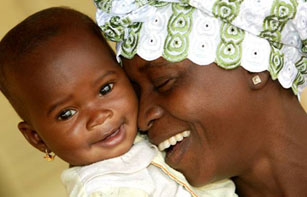
Credit: UNAIDS/P. Virot
The World Health Organization (WHO) has published its first ever list of 30 priority medicines for maternal and child health. The list includes medicines for children living with HIV as well as a triple combination of drugs to prevent mother-to-child transmission of HIV.
Compiled by experts in maternal and child health and medicines, the list is based on the WHO Model List of Essential Medicines and the latest WHO treatment guidelines. It provides a concrete way forward in striving to achieve global health goals[i].
The health situation for many women and children across the globe remains precarious. Despite a decline since 2004, in 2009 an estimated 260 000 children under the age of 15 died from AIDS-related illness[ii]. Every day some 1000 women lose their lives due to complications during pregnancy and childbirth. Most of these deaths can be prevented if the correct medicines in the correct formulations are prescribed and used in the correct way.
Many of the medicines can be administered quickly and easily. For example, a single injection of oxytocin can stop a woman bleeding to death if she haemorrhages after childbirth.
Preventing mother-to-child transmission of HIV
The WHO-recommended drug regimen of prolonged use of combination of three antiretroviral (ARV) drugs to prevent mother-to-child transmission of HIV is also highlighted in the priority medicines list.
Positive results from a WHO-led study that were published in The Lancet in January 2011 showed that giving pregnant women living with HIV a combination of three ARV drugs during the last trimester of pregnancy, through delivery and six months of breastfeeding can reduce the risk of their baby being infected with HIV by more than 40% compared to the use of a single-dose ARV drug regimen which stopped at delivery as had been recommended by WHO since 2004.
Children and HIV
Without effective HIV treatment, an estimated one third of infants living with the virus will have died by one year of age, and about half will have died by two years of age. The list includes recommendations in the area of paediatric AIDS. Appropriate doses of the right combinations of antiretrovirals are critical to reducing child deaths from AIDS-related illness.
According to WHO, additional research and development is also urgently needed for appropriate products for prevention and treatment of tuberculosis, particularly in children living with HIV.
This list is designed to help countries prioritize, so that they focus on getting the most critical things available and save the most lives
Dr Elizabeth Mason, Director of WHO's Department of Maternal, Newborn, Child and Adolescent Health
Despite these pressing needs, surveys conducted in 14 African countries show that children's medicines are available in only 35% to 50% of pharmacies and drug stores[iii]. There is also a lack of awareness that children need different medicines from adults. When adult medicines are fractioned into smaller parts for children, the dose can be inaccurate and the medicine hard to swallow.
WHO recommends that, wherever possible, medicines for children should be provided in doses that are easy to measure and easy to take. There should also be steps to ensure that medicines are appropriate for the intended setting.
"Medicines produced in liquid form are more expensive than tablets or powders and are also more difficult to store, package, and transport, due to their bulk, weight and need for refrigeration. The list we have drawn up tells manufacturers exactly what they should be producing to meet countries’ needs," said Dr Hans V. Hogerzeil, Director of WHO's Department for Essential Medicines and Pharmaceutical Policies.
The release of the list of top 30 medicines to save mothers and children was timed to coincide with the meeting of the 18th Expert Committee on the Selection and Use of Essential Medicines. The meeting took place in Ghana, 21-25 March 2011. “This list is designed to help countries prioritize, so that they focus on getting the most critical things available and save the most lives," said Dr Elizabeth Mason, Director of WHO's Department of Maternal, Newborn, Child and Adolescent Health.
[i] Millennium Development Goals 4, 5 & 6: Reduce child mortality; Improve maternal health; Combat HIV/AIDS, malaria and other diseases.
[ii] UNAIDS global report 2010
[iii] Jane Robertson, Gilles Forte, Jean-Marie Trapsida & Suzanne Hill. What essential medicines for children are on the shelf? Bulletin of the World Health Organization 2009;87:231-237. doi: 10.2471/BLT.08.053645




